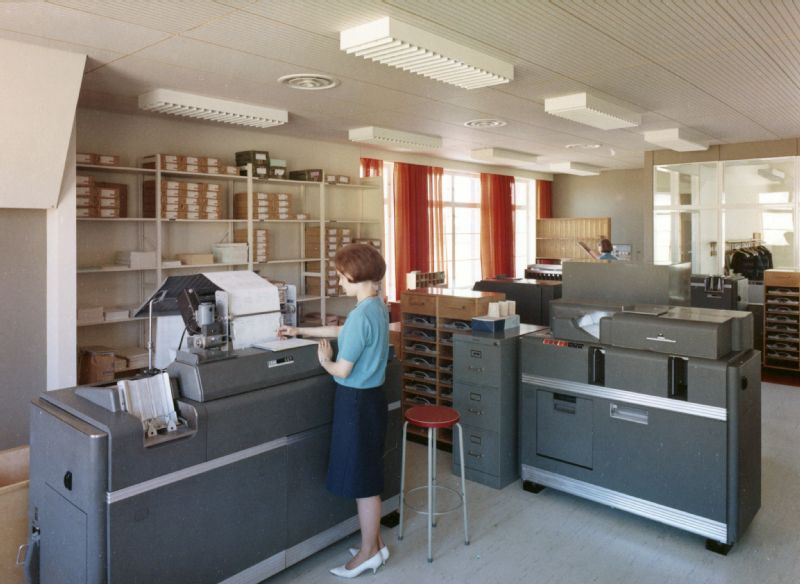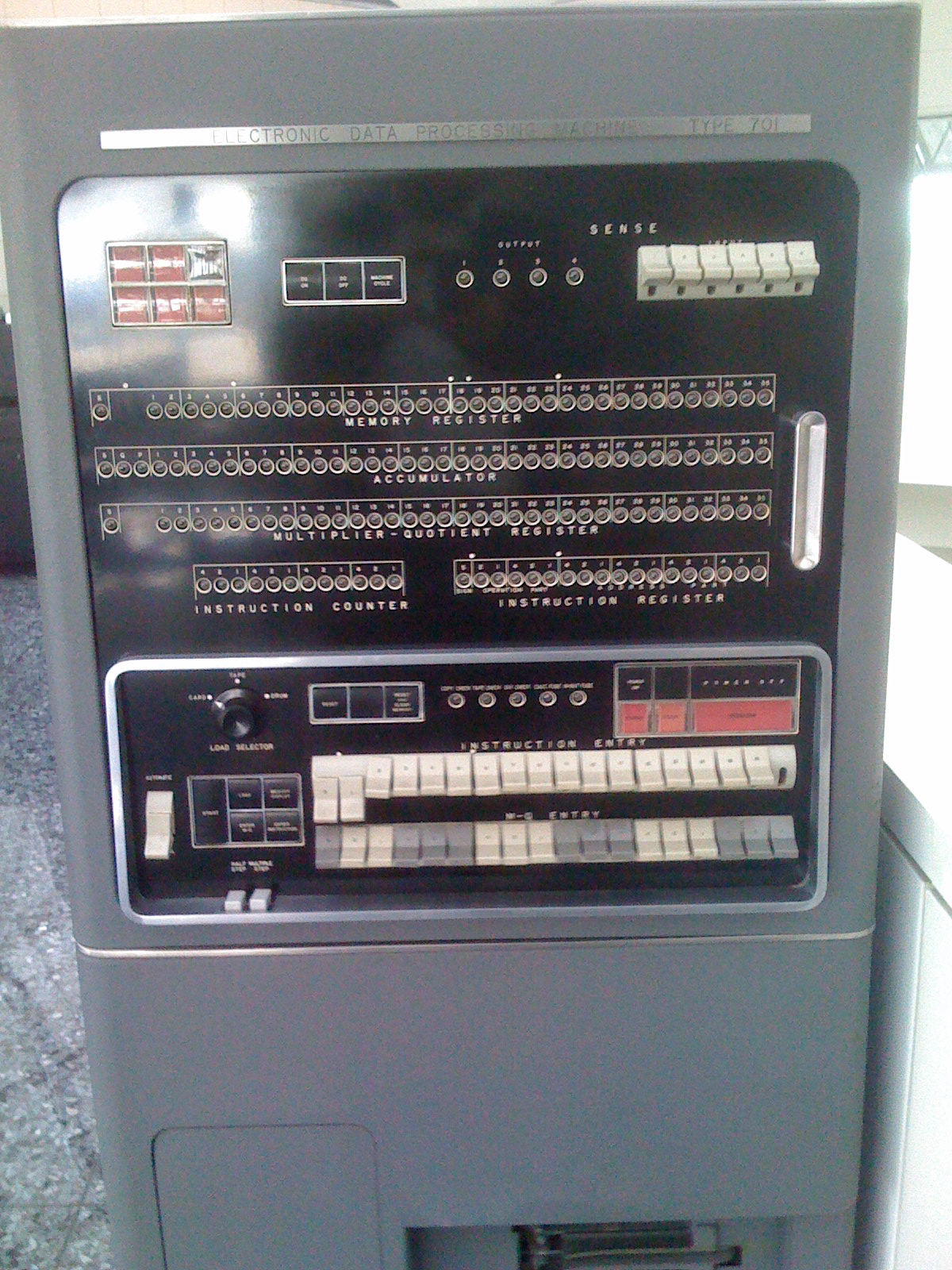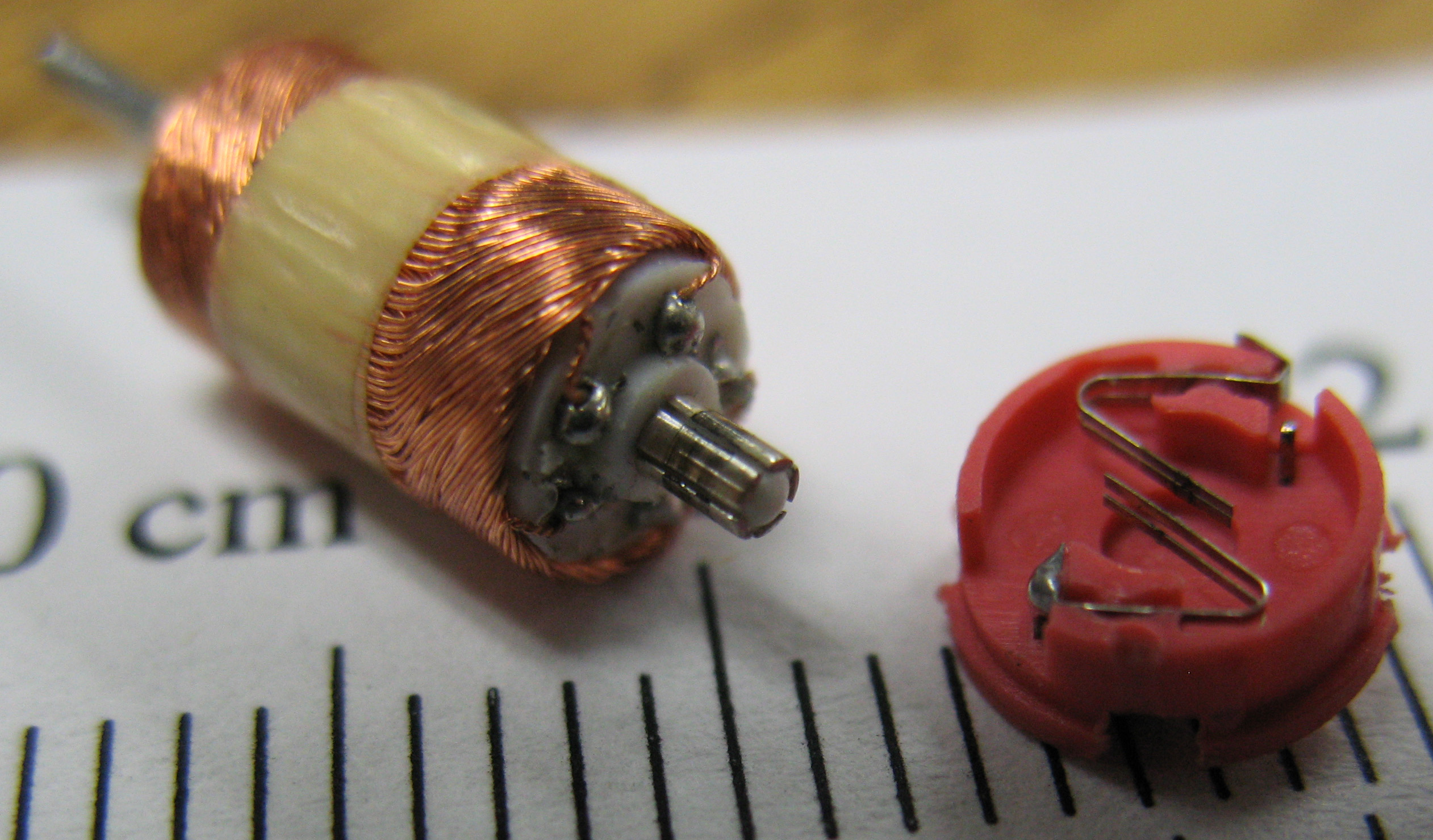|
IBM 407
The IBM 407 Accounting Machine, introduced in 1949, was one of a long line of IBM tabulating machines dating back to the days of Herman Hollerith. It had a card reader and printer; a summary punch could be attached. Processing was directed by a control panel. The 407 was the central component of many unit record equipment shops which were the mainstay of IBM's business at the time. It could print digits, letters and several special characters in any of 120 print positions, spaced . In 1976 the IBM 407 Accounting Machine was withdrawn from marketing. Description The 407 read punched cards, totaled fields on the cards, made simple decisions, printed results, and, with the aid of a summary punch, output results on punched cards that could be input to other processing steps. The operation of the 407 was directed by the use of a removable control panel and a carriage tape. Exit hubs (impulse emitting) on the control panel are wired to entry hubs (impulse accepting) for the t ... [...More Info...] [...Related Items...] OR: [Wikipedia] [Google] [Baidu] |
Redstone Arsenal
Redstone Arsenal (RSA) is a United States Army post and a census-designated place (CDP) adjacent to Huntsville in Madison County, Alabama, United States and is part of the Huntsville-Decatur Combined Statistical Area. The Arsenal is a garrison for various tenants across the Department of Defense, Department of Justice, and NASA. RSA has benefited from decisions by the Defense Base Realignment and Closure Commission. The Redstone Arsenal CDP had a residential population of 837 as of the 2020 census. The base contains a government and contractor workforce that averages 36,000 to 40,000 personnel daily. Established during World War II as a chemical manufacturing facility, in the immediate post-war era the Arsenal was used for research and development by German weapons rocket scientists who were brought to the U.S. as part of Operation Paperclip. The team first worked on ballistic missiles, starting with V-2 rocket derivatives, before moving on to a series of ever larger designs. Man ... [...More Info...] [...Related Items...] OR: [Wikipedia] [Google] [Baidu] |
Carriage Tape
A carriage control tape was a loop of punched tape that was used to synchronize rapid vertical page movement in most IBM and many other line printers from unit record days through the 1980's. The tape loop was as long as the length of a single page. A pin wheel moved the tape accurately using holes in the center of the tape. A hole punched in one of the other channels represented a particular position on the page. Channel one was typically used to indicate the top of the page and might be the only channel used. Another channel might indicate the summary line on an invoice, enabling rapid skipping to that line. IBM provides a special manual punch that allowed accurate placement of the channel punches. Skipping occurred under computer control, but a form feed switch on the printer control panel allowed a manual skip to the top of the page. The tapes could be easily changed when new, continuously fed forms were loaded into the printer. Forms control buffer Newer printers use a "form ... [...More Info...] [...Related Items...] OR: [Wikipedia] [Google] [Baidu] |
IBM 1130
The IBM 1130 Computing System, introduced in 1965, was IBM's least expensive computer at that time. A binary 16-bit machine, it was marketed to price-sensitive, computing-intensive technical markets, like education and engineering, succeeding the decimal IBM 1620 in that market segment. Typical installations included a 1 megabyte disk drive that stored the operating system, compilers and object programs, with program source generated and maintained on punched cards. Fortran was the most common programming language used, but several others, including APL, were available. The 1130 was also used as an intelligent front-end for attaching an IBM 2250 Graphics Display Unit, or as remote job entry (RJE) workstation, connected to a System/360 mainframe. Description The total production run of the 1130 has been estimated at 10,000. The 1130 holds a place in computing history because it (and its non-IBM clones) gave many people their first direct interaction with a computer. Its pri ... [...More Info...] [...Related Items...] OR: [Wikipedia] [Google] [Baidu] |
Line Printer
A line printer prints one entire line of text before advancing to another line. Most early line printers were impact printers. Line printers are mostly associated with unit record equipment and the early days of digital computing, but the technology is still in use. Print speeds of 600 lines per minute (approximately 10 pages per minute) were achieved in the 1950s, later increasing to as much as 1200 lpm. Line printers print a complete line at a time and have speeds in the range of 150 to 2500 lines per minute. The types of line printers are drum printers, band-printers, and chain printers. Other non-impact technologies have also been used, as thermal line printers were popular in the 1970s and 1980s, and some inkjet and laser printers produce output a line or a page at a time. Designs Many impact printers, such as the daisywheel printer and dot matrix printer, used a print head that printed a character then moved on until an entire line was printed. Line printers we ... [...More Info...] [...Related Items...] OR: [Wikipedia] [Google] [Baidu] |
IBM 1132
The IBM 1132 line printer was the normal printer for the IBM 1130 computer system. It printed 120 character lines at 80 lines per minute. The character set consisted of numbers, upper-case letters and some special characters. The 1965-introduced 1132 was built around a stripped down IBM 407 printing mechanism. The 407 was IBM's top-of-the-line accounting machine from the 1950s. The 1130 had 120 power transistors, each wired to the print magnet for one printer column. The magnet released a lever that engaged a cam with a spinning clutch shaft. The engaged cam then made one revolution, pushing its print wheel toward the ribbon and paper, thereby printing one character. As the set of 120 print wheels spun, the 1130 received an interrupt In digital computers, an interrupt (sometimes referred to as a trap) is a request for the processor to ''interrupt'' currently executing code (when permitted), so that the event can be processed in a timely manner. If the request is accepted, ... [...More Info...] [...Related Items...] OR: [Wikipedia] [Google] [Baidu] |
IBM 650
The IBM 650 Magnetic Drum Data-Processing Machine is an early digital computer produced by IBM in the mid-1950s. It was the first mass produced computer in the world. Almost 2,000 systems were produced, the last in 1962, and it was the first computer to make a meaningful profit. The first one was installed in late 1954 and it was the most-popular computer of the 1950s. The 650 was marketed to business, scientific and engineering users as a general-purpose version of the IBM 701 and IBM 702 computers which were for scientific and business purposes respectively. It was also marketed to users of unit record equipment, punched card machines who were upgrading from Unit record equipment#Calculating, calculating punches, such as the IBM 604, to computers. Because of its relatively low cost and ease of Computer programming, programming, the 650 was used to pioneer a wide variety of applications, from modeling submarine crew performance to teaching high school and college students c ... [...More Info...] [...Related Items...] OR: [Wikipedia] [Google] [Baidu] |
IBM 700/7000 Series
The IBM 700/7000 series is a series of large-scale (Mainframe computer, mainframe) computer systems that were made by IBM through the 1950s and early 1960s. The series includes several different, incompatible processor architectures. The 700s use vacuum-tube logic and were made obsolete by the introduction of the transistor computer, transistorized 7000s. The 7000s, in turn, were eventually replaced with System/360, which was announced in 1964. However the 360/65, the first 360 powerful enough to replace 7000s, did not become available until November 1965. Early problems with OS/360 and the high cost of converting software kept many 7000s in service for years afterward. Architectures The IBM 700/7000 series has six completely different ways of storing data and instructions: *First scientific (36/18-bit words): IBM 701, 701 (Defense Calculator) *Later scientific (36-bit words, hardware floating-point): IBM 704, 704, IBM 709, 709, IBM 7040, 7040, IBM 7044, 7044, IBM 7090, 7090, I ... [...More Info...] [...Related Items...] OR: [Wikipedia] [Google] [Baidu] |
IBM 701
The IBM 701 Electronic Data Processing Machine, known as the Defense Calculator while in development, was IBM’s first commercial scientific computer and its first series production mainframe computer, which was announced to the public on May 21, 1952. It was invented and developed by Jerrier Haddad and Nathaniel Rochester based on the IAS machine at Princeton. The IBM 701 was the first computer in the IBM 700/7000 series, which were IBM’s high-end computers until the arrival of the IBM System/360 in 1964. The business-oriented sibling of the 701 was the IBM 702 and a lower-cost general-purpose sibling was the IBM 650, which gained fame as the first mass-produced computer in the world. History IBM 701 competed with Remington Rand's UNIVAC 1103 in the scientific computation market, which had been developed for the NSA, so it was held secret until permission to market it was obtained in 1951. In early 1954, a committee of the Joint Chiefs of Staff requested that the two ma ... [...More Info...] [...Related Items...] OR: [Wikipedia] [Google] [Baidu] |
Overclock
In computing, overclocking is the practice of increasing the clock rate of a computer to exceed that certified by the manufacturer. Commonly, operating voltage is also increased to maintain a component's operational stability at accelerated speeds. Semiconductor devices operated at higher frequencies and voltages increase power consumption and heat. An overclocked device may be unreliable or fail completely if the additional heat load is not removed or power delivery components cannot meet increased power demands. Many device warranties state that overclocking or over-specification voids any warranty, however there are an increasing number of manufacturers that will allow overclocking as long as performed (relatively) safely. Overview The purpose of overclocking is to increase the operating speed of a given component. Normally, on modern systems, the target of overclocking is increasing the performance of a major chip or subsystem, such as the main processor or graphics cont ... [...More Info...] [...Related Items...] OR: [Wikipedia] [Google] [Baidu] |
Relay
A relay Electromechanical relay schematic showing a control coil, four pairs of normally open and one pair of normally closed contacts An automotive-style miniature relay with the dust cover taken off A relay is an electrically operated switch. It consists of a set of input terminals for a single or multiple control signals, and a set of operating contact terminals. The switch may have any number of contacts in multiple contact forms, such as make contacts, break contacts, or combinations thereof. Relays are used where it is necessary to control a circuit by an independent low-power signal, or where several circuits must be controlled by one signal. Relays were first used in long-distance telegraph circuits as signal repeaters: they refresh the signal coming in from one circuit by transmitting it on another circuit. Relays were used extensively in telephone exchanges and early computers to perform logical operations. The traditional form of a relay uses an electromagnet to c ... [...More Info...] [...Related Items...] OR: [Wikipedia] [Google] [Baidu] |
Commutator (electric)
A commutator is a rotary electrical switch in certain types of electric motors and electrical generators that periodically reverses the current direction between the rotor and the external circuit. It consists of a cylinder composed of multiple metal contact segments on the rotating armature of the machine. Two or more electrical contacts called " brushes" made of a soft conductive material like carbon press against the commutator, making sliding contact with successive segments of the commutator as it rotates. The windings (coils of wire) on the armature are connected to the commutator segments. Commutators are used in direct current (DC) machines: dynamos (DC generators) and many DC motors as well as universal motors. In a motor the commutator applies electric current to the windings. By reversing the current direction in the rotating windings each half turn, a steady rotating force (torque) is produced. In a generator the commutator picks off the current generated in ... [...More Info...] [...Related Items...] OR: [Wikipedia] [Google] [Baidu] |




.jpg)



